Welcome to the Comment of the Week, where we highlight good comments in order to inspire more of them. You can help us choose our next one by replying with “comment of the week” to any comment you think deserves recognition. Please note: These selections are not endorsements.
I try really hard to stay well-informed but, try as I may, grasping the ins and outs of the Interstate Bridge Replacement Program usually gets the best of me. That is why I was so happy when one BikePortland commenter wrote up a handy cheat sheet for all of the conflicting interests. I keep mine on the refrigerator.
But you could also print it out in a really small font, laminate it, and keep it in your wallet.
Whatever you decide to do with it, enjoy John D’s wry comment in response to our most recent IBRP post, Beg, borrow, and deal: Lawmakers float $1 billion I-5 freeway expansion funding plan:
Yes, they are trying to solve all the competing transportation challenges with a single project. Hence why the common sense alternative proposal is so appealing.
- The bridge can’t be too high, or the FAA won’t approve it due to Pierson [sic] Field.
- The bridge can’t be too low, or the Coast Guard won’t approve it without a draw bridge.
- The DoTs don’t want to stop freeway traffic for bridge lifts.
- Clark County doesn’t want transit.
- Portland won’t support it without transit.
- They have to accommodate interstate traffic traveling long distances.
- They have to provide local connections for downtown Vancouver, Hayden Island, and the industrial areas.
Clearly all of those would be better serves by a series of smaller, focused projects, not a single one, but that’s not how our funding system is set up. Instead of long term, sustainable (financial and environmental) thinking, we throw billions at giant capital projects, but not at maintaining them once they’re built. We just assume that in another 50 years there will be another mega-project that will replace the current mega-project.
But wait!!! There’s more! Apparently John D left something out. Luckily Chris caught the oversight.
You forgot one, the Coast Guard doesn’t want additional bridge piers between the existing I-5 bridge and the railroad bridge. It will further complicate the currents for ships.
Thank you John D and Chris! You can find John D’s comment , and Chris’s too, under the original post.



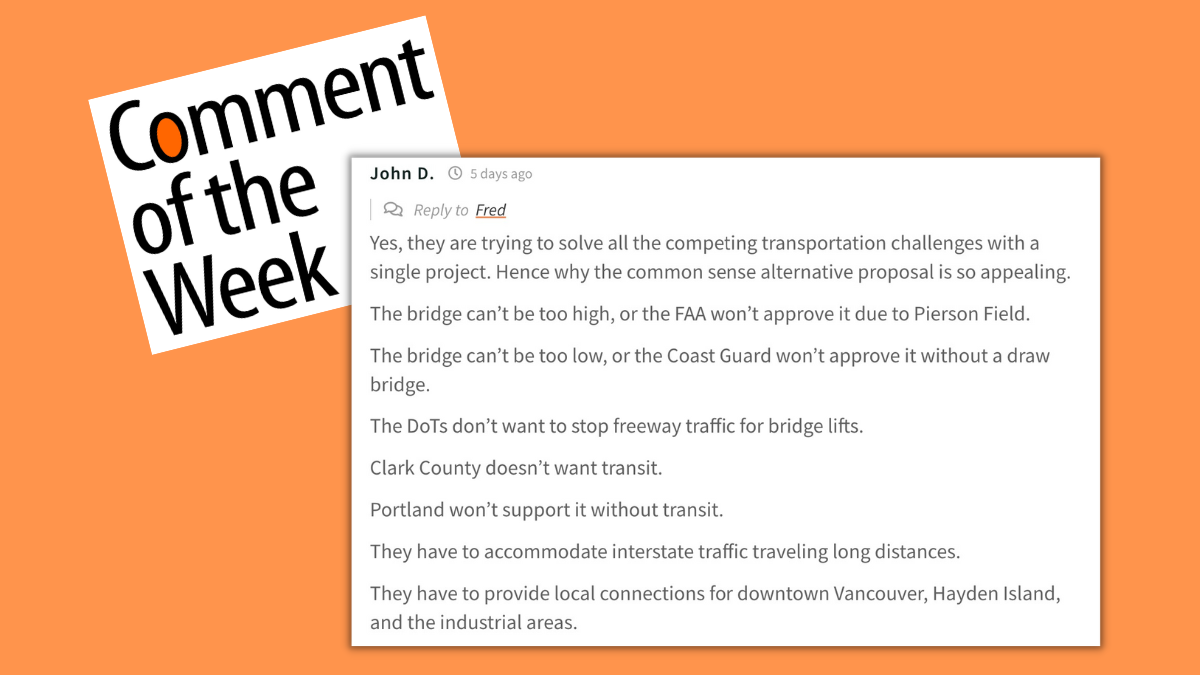
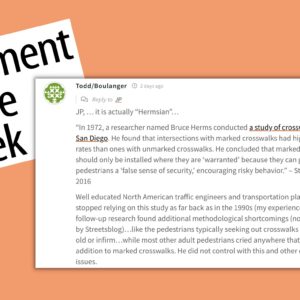
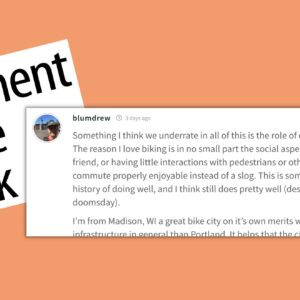
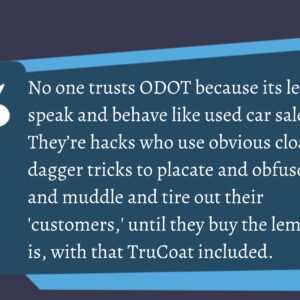
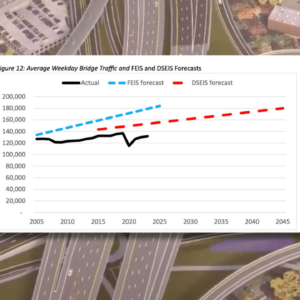
Thanks for reading.
BikePortland has served this community with independent community journalism since 2005. We rely on subscriptions from readers like you to survive. Your financial support is vital in keeping this valuable resource alive and well.
Please subscribe today to strengthen and expand our work.
Yep: and…
*But, we should not expect that the Federal government will be as generous with highway infrastructure in 50 years (debt, shift from private cars, new technology etc.)…so we should really be thinking of this bridge as a 100 to 200 year lifespan facility…just like our great grand parents expected before the Federal State DOTs got involved…like the locally bonded and toll funded 1917 Interstate Bridge (1.0).
*”We just assume that in another 50 years there will be another mega-project that will replace the current mega-project.” – John D
Serious question: what current bridge construction technology can be expected to have a designed lifespan of 150 years? Something made of replaceable parts that can be individually tested while in use and switched out at need?
If we expend resources to make a 100+ year bridge there’s an implicit assumption that we’re going to need that thing in 2130 and beyond.
The next project will be to rip the worthless bridge down and build a tunnel to restore Vancouver’s historic River District on the north bank of the Columbia.
Wasn’t the original railroad bridge built by James Hill, not Sam? The Northern Pacific finished the line with the completion of the bridge in 1908. I wouldn’t pretend to know any detailed history of Northern Pacific though, too many bankruptcies and power struggles to keep straight.
BNSF doesn’t want to pay for any railroad bridge changes. But if the Coast Guard declared it a hazard to navigation and the feds ponied up enough money there is no reason that the current bridge couldn’t be altered. The Willamette bridge was changed from a swing to lift span in the late 80s after a collision with the swing span pier. Granted, this all happened in a different era of railroading and before the Santa Fe merger (and before the Warren Buffet takeover).
I believe it was James Hill and built under the SP&S railroad:
https://en.wikipedia.org/wiki/Spokane,_Portland_and_Seattle_Railway
And I also think a Public-Private-Partnership would be the best approach to the BNSF bridge. Rebuild it as a 3 or 4-track bridge with a opening span that aligns better with the Interstate crossing. If we are serious about rail travel between Portland and Seattle, this bridge is going to be a future choke point.
Ah yes – Northern Pacific built the line from Seattle to Vancouver, but SP&S built the Portland-Vancouver leg (as well as the Vancouver-Spokane leg that the Empire Builder runs on now). Although SP&S was a joint operation by two Hill lines anyways (Great Northern + Northern Pacific).
I’d like to see 4 tracks. It’s a big choke point for freight in the region as is, so two tracks for freight + two for passenger (which would give plenty of capacity for S-Bahn style service in the Portland region) seems like a good idea to me.
I thought the US Coast Guard did declare BNSF Bridge 9.6 a navigational “hazard” back during the CRC…or just another fever dream?
Todd — the BNSF swing bridge was completed in 1908, not 1910.
https://en.wikipedia.org/wiki/Burlington_Northern_Railroad_Bridge_9.6
Just keeping the data clean!
Ted Buehler
Aloha Ted! And thanks to everyone for correcting my lunch time rushed (sloppy from memory) text pecking. 😉
…There are just too many Hills in PNW infrastructure and the “Good [For Cars Only] Roads Movement: as Sam Hill married James’ Hill’s daughter (and poor Mary Hill became Mary Hill Hill among other sad things for the Hill’s…)
https://en.wikipedia.org/wiki/Samuel_Hill
https://www.oregonencyclopedia.org/articles/columbia_river_highway/#.ZCy5yy2cai4
Thousands of years ago, the bad ass Chinooks, who could live anywhere, choose to live on the north bank of the Columbia on land that became Vancouver’s historic River Distric. Then the Hudson Bay company, who could put a Fort anywhere, choose what is now nearby Fort Vancouver. I-5 destroyed Vancouver’s River District and disconnected downtown Vancouver from the Fort. The only good thing about the I-5 bridge replacement project is the opportunity to bury that mistake in a tunnel. Otherwise, no point in building it. Build a tunnel and you will go a long way toward making Vancouver great again. Compared to that opportunity, nothing else about the worthless project matters.
Just a quick comment. Back a decade or so ago, when I still lived in Oregon, I remember looking at the requirements and there was either a 6′ gap between the Coast Guard requirements and the FAA requirements or there was a 6′ overlap between the requirements. But in either case, it was physically impossible to build a bridge that met both requirements. So, I sent a letter off to the editor of the Oregonian asking why we don’t use a tunnel, then. The replies I saw back then were that it’s too expensive. Funny thing, if they started it back then I bet it would be cheaper than a slab bridge would be now.
Clark County WILL accept transit — the “high capacity” transit offered by Bus Rapid Transit. C-Tran presently has one BRT line up and running and is constructing their 2nd BRT line. TriMet has their first BRT line now up and running in SE Portland.
There is no need for a $2 billion 3-mile light rail extension into Vancouver. The transit funding would better serve the people being spent on other, much more “affordable” transit service.
So far, each C-Tran BRT line has cost around $50 million. You could build FORTY new BRT lines for the price of the 3-mile MAX light rail extension being proposed.
What is the “need” for transit at this time, let alone “high capacity” transit?
If there were a legitimate “demand” for transit, BOTH TriMet and C-Tran would be providing transit service over the Columbia River.
The sad reality is that cross river transit ridership began declining roughly a decade ago. Prior to the pandemic lockdowns, C-Tran offered SEVEN separate routes across the Columbia River using both I-5 and I-205. Those 7 bus routes carried only about 1,400 people a day.
Once the pandemic lockdowns happened, ridership dropped below 1,000 a day. C-Tran responded by reducing their 7 routes to 5 routes.
Neither C-Tran nor TriMet are expecting ridership to return to pre pandemic levels any time this decade.
The IBR lied when they projected 26,000-33,000 average daily riders on just the I-5 corridor by 2045. Nobody believed those numbers. In December, the IBR quietly reduced that projection by 2/3 to just 11,000 average daily riders on the I-5 corridor by 2045. Even that is likely to be extremely optimistic.
C-Tran system ridership peaked in 1999 at 7.75 million annual boardings. They were running relatively flat ridership around 6 million boardings, prior to the pandemic. They are hoping system ridership will return to 75 percent of pre pandemic levels by 2027.
Clark County population was 347,000 in 2000, and 425,000 in 2010. It grew to 503,000 in 2020. Yet ridership on transit has been in decline.
TriMet ridership peaked in 2012, at the end of the Great Recession.
While we might “wish” for increased transit ridership, just like we “wish” for more bike ridership and active transportation, the reality is that both have declined over the past few years.